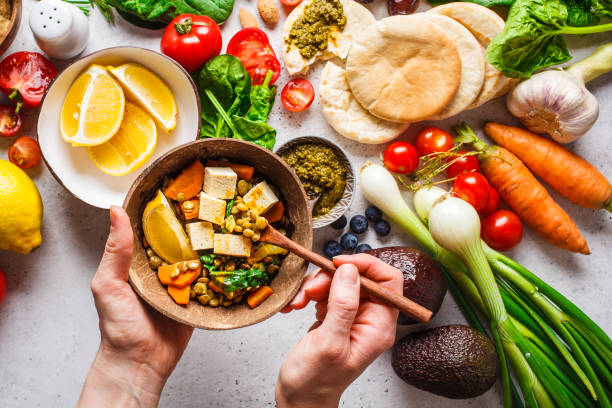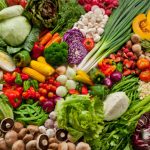Certain fruits and vegetables can be good natural sources of vitamin A. Others are rich in vitamin C and folate. Most fruits and vegetables are low in calories and fat, while others have very little cholesterol. Many are also rich sources of fibre. You can also enjoy the wonderful textures and flavours of fruits and vegetables.
This article will discuss the benefits of eating balanced meals. We will also focus on specific foods and eating habits that offer the greatest health benefits. Let’s start by looking at the recommended daily intake of fruits and veggies.
Get More Produce
According to the latest MyPyramid guidelines, a person who consumes 2,000 calories per day should have 2 cups of fruits and 2 cups of vegetables daily. Higher or lower amounts of fruit and vegetables are recommended depending on your caloric requirements.
Extra servings of vegetables and fruits can help you cut down on calories and fat. These are great and delicious alternatives to high-calorie sweets and meats. Here’s how much is one cup?
Fruits
- 1 medium-sized piece of fruit
- 1 cup chopped or cooked fruit
- 1 large banana
- 1/4 cup cantaloupe
- 1/2 cup dried fruit
- 1 cup of berries or grapes
- 1 cup 100% fruit juice
Vegetables
- 1 cup cooked or raw vegetables
- 2 cups of raw leafy vegetables
- 1 cup baby carrots (approximately 12)
- 1 medium potato
- 1 cup canned, dried beans, peas or cooked beans
- 1 cup vegetable juice
Are you unsure which vegetables and fruits contain the vitamins or nutrients you require? This section will give you an indication of the colour of a fruit or vegetable.
Eat A Rainbow
It’s good to eat more fruits and vegetables if you don’t eat much produce. To get the most bang for your buck, think about colour. It is a great way to get the best nutritional value from your fruits and vegetables. A diet based on colourful fruits and veggies is endorsed by the National Cancer Institute, American Cancer Society, and the Produce for Better Health Foundation.
Many times, the more nutrients a fruit or vegetable has, the darker it is, the better. For example, spinach has eight times the vitamin C of iceberg lettuce and red grapefruit has 25 times as much vitamin A as a white one. Every fruit and vegetable is different, offering a unique combination of vitamins, minerals and fibre that provides benefits. It is important to try all colours and eat different varieties within each group. Here are some ways to broaden your product selection.
Blue and Purple
These fruits and veggies contain various health-promoting phytonutrients such as anthocyanins and polyphenols. These foods’ rich colours are a strong source of antioxidants because they contain powerful pigments. These products, including blue and purple fruits, can provide extra protection from certain types of cancer and infections to the urinary tract. They also may boost vision and brain health.
Fruits Blueberries, elderberries, blackberries, currants, currants (black), grapes(purple), plums and prunes, raisins
Vegetables: Asparagus (purple), Belgian endive (purple), cabbage (purple), carrots (purple), eggplant, peppers (purple), potatoes (purple-fleshed)
Green
Vegetables and green fruits contain varying phytochemicals such as lutein, indoles and other essential nutrients. These substances can lower your risk of developing cancer, improve your eye health, and help keep your bones and teeth healthy.
Fruits: Apples (green), avocados, grapes (green), honeydew, kiwifruit, limes, pears (green)
Vegetable Artichokes
White/Tan/Brown
Vegetables and fruits that are white, tan or brown contain different phytonutrients. These vegetables and fruits play an important role in heart health, helping to maintain healthy cholesterol levels and may help lower your risk of certain types of cancer.
Fruits: Bananas, dates, nectarines (white), peaches (white), pears (brown)
Vegetables: Cauliflower, corn (white), garlic, ginger, Jerusalem artichoke, jicama, kohlrabi, mushrooms, onions, parsnips, potatoes (white-fleshed), shallots, turnips
Yellow and Orange
There are varying amounts of antioxidants in orange and yellow vegetables and fruits and other phytonutrients like carotenoids or bioflavonoids. These substances can help maintain healthy eyesight, heart health, and a healthy immune system. They may also help prevent cancer.
Fruits: Apples (yellow), apricots, cantaloupe, cape gooseberries, figs (yellow), grapefruit, kiwifruit (golden), lemons, mangoes, nectarines, oranges, papaya, peaches, pears (yellow), persimmons, pineapple, tangerines, watermelon (yellow)
Vegetable Beets (yellow), corn (sweet), tomatoes (yellow), peppers (yellow), potatoes(yellow), pumpkin (butternut), squash, squash (yellow season), squash, squash (yellow Winter), sweet potatoes, and tomatoes (yellow).
Red
Anthocyanins, ellagic acids, and lycopene are some of the phytonutrients found in red fruits with health-promoting effects. Red fruits and veggies may benefit your heart, memory, and urinary tract health. They also help to lower the chance of certain types of cancer.
Fruits Cherry, cranberries and grapefruit (pink/red), grapefruit (red), grapefruit (red), grapes, oranges, pears, pomegranates (red), strawberries, watermelon, raspberries, strawberries, and grapefruit (red).
Vegetables Beets and onions (red), peppers red, potatoes (red), radicchio and radishes.



